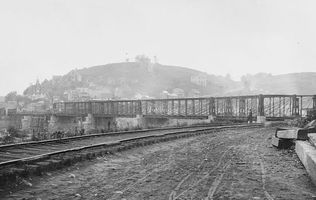
Bollman truss bridges were the first successful all-iron railroad bridges used in the United States. More than 100 of these bridges were built between 1850 and 1870, mostly on the Baltimore & Ohio Railroad. Wendel Bollman, who was master of the road and responsible for the maintenance of track and structures, designed the iron bridge to replace poorly constructed wood and stone bridges on the B&O. The Bollman truss spans at Harpers Ferry were the largest and most impressive examples of this type of bridge.
Truss bridges were composed of individual groups of wood or iron members arranged in the form of a triangle. The Bollman truss span consisted of a series of simple king post trusses. Thus Bollman truss bridges had long runs of iron rods that gave them a ‘‘spiderweb’’ look.
In 1851, the ‘‘Winchester’’ span of the Harpers Ferry bridge was constructed to carry the Winchester & Potomac Railroad to a junction in mid-river with the B&O. In 1862, four Bollman truss spans were built from the Maryland side. Although damaged during the Civil War, they were repaired and new Bollman spans were added. The new Harpers Ferry bridge was completed in 1868. This magnificent bridge had eight Bollman truss spans of different lengths with the W&P junction in the river and a sharp curve onto the West Virginia bank at the west end. The bridge continued in use until 1894 when new bridges were constructed and some of the remaining Bollman trusses were converted to highway use. On March 19, 1936, the Potomac River at Harpers Ferry crested at a record 36.50 feet, 15 feet above flood level. The flooding destroyed the last Bollman spans.
This Article was written by Robert L. Frey
Last Revised on October 13, 2023
Related Articles
Sources
Harwood, Herbert H. Jr. Impossible Challenge: The Baltimore and Ohio Railroad in Maryland. Baltimore: Barnard, Roberts & Co., 1979.
Cite This Article
Frey, Robert L. "Bollman Truss Bridge." e-WV: The West Virginia Encyclopedia. 13 October 2023. Web. 26 July 2024.



Comments?
There aren't any comments for this article yet.
Click here to read and contribute to the discussion →